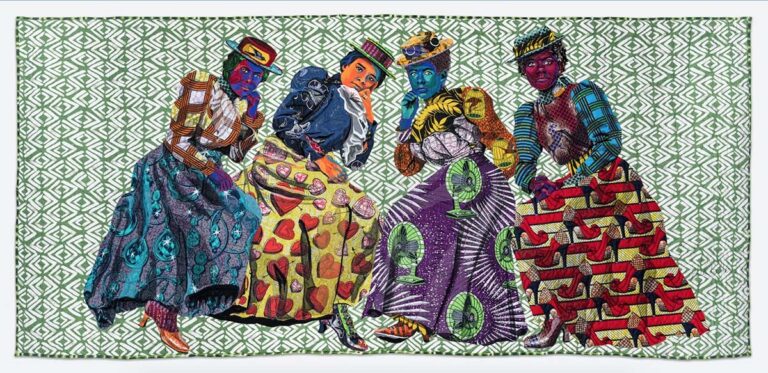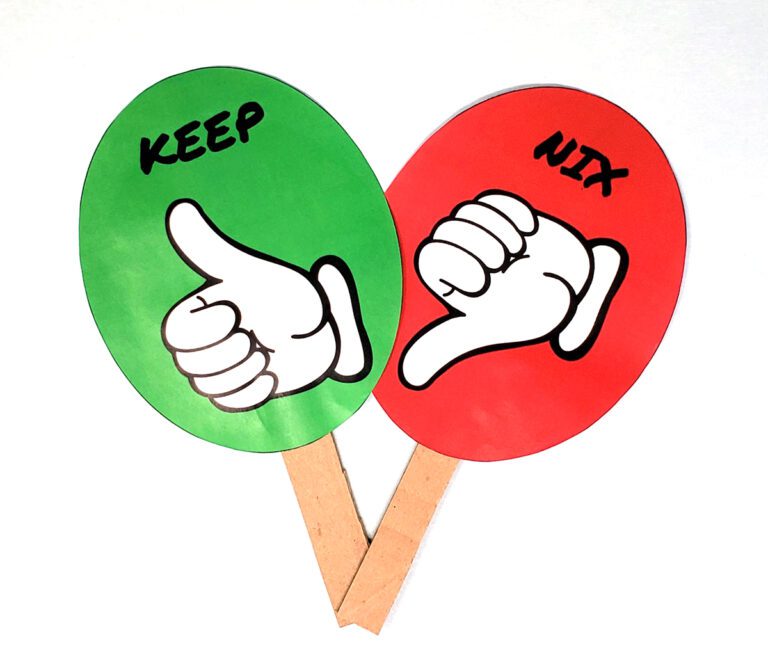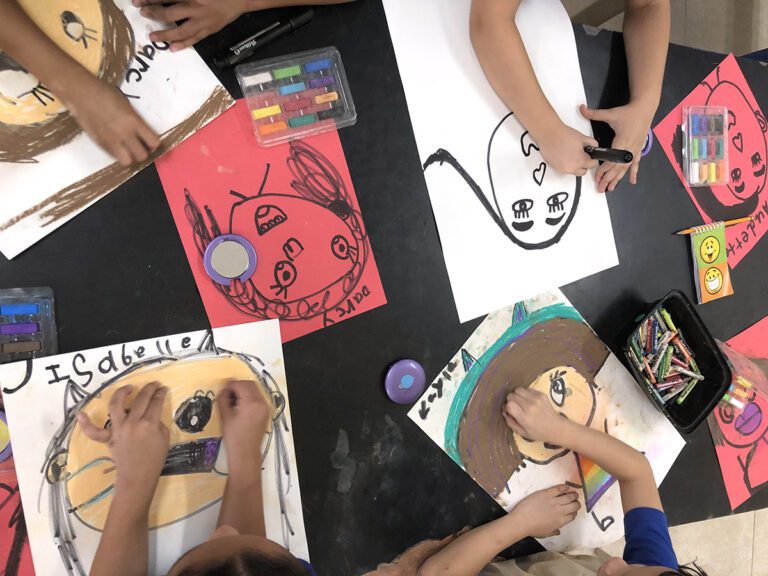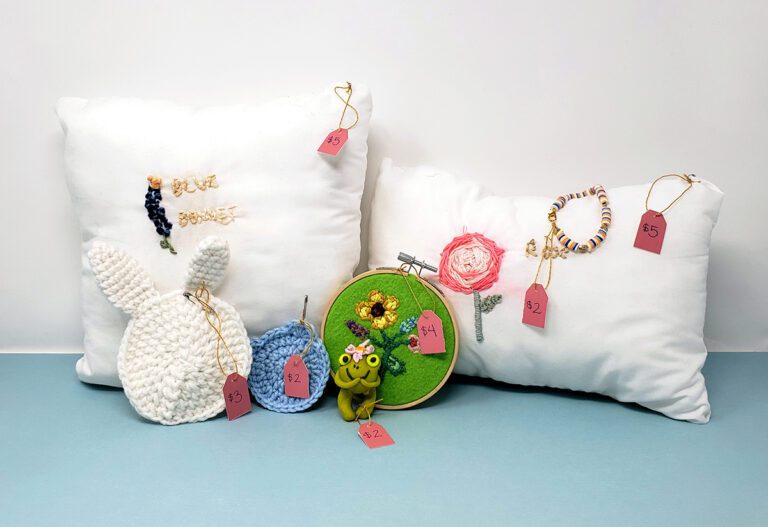Are you looking for a new way to assess students in the art room, implement technology and support your building’s new literacy initiative?
Well, it turns out, there just might be an APP for that!
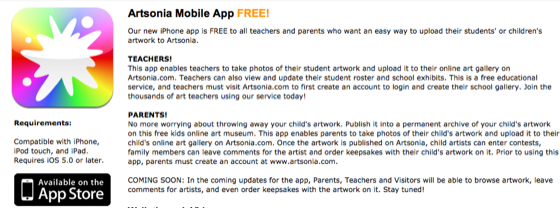
Artsonia (the world’s largest kids’ art museum, with over 21 million artworks online) has recently unveiled a new feature: Artist Statements! What does this mean to you? Well, it might mean that it is time to see what Artsonia is all about and if it has a place in your curriculum.
Let’s talk first about the importance of Artist Statements.
True artist statements provide insight into artwork in order to enhance the artist’s vision and to allow the viewer the opportunity to see the process through the eyes of the artist. Artist statements are personal, and often revealing, written pieces that involve literacy, composition, and higher order thinking skills. Artist statements are a natural way to implement writing into your art curriculum and just happen to support English Language Arts Common Core State Standards as well.
Have you written an artist statement lately?
Students in the AOE Assessment in Art Education course were recently challenged to do just that. They quickly learned (or remembered from the days of undergrad) that writing an artist statement is no simple task. Here are some participants’ feedback about the rigor of this assignment:
“Challenging, but worth it!”
“A HUGE sense of accomplishment (now that I made it through the process)!”
“I learned a lot about myself along the way and cannot wait to give my students a similar experience.”
If you are not sure how to begin using artist statements in your classroom, consider signing up for Assessment in Art Education beginning October 1st. We will spend an entire week learning about the elements of a successful artist statement and sharing ideas for implementation that you can use immediately. Every grade level can benefit from some form of artist statements. We will show you how to make artist statements work for you.
How does Artsonia support the use of Artist Statements?
Art instructor, Diane Davis, from Parker Middle School in Massachusetts, is a pro when it comes to utilizing Artsonia’s artist statement feature. I recently had the opportunity to interview Diane and learn about the “nuts and bolts” of her well-developed process.
Here is what I found out.
Could you give readers a little background about yourself (grades you teach, years of experience, etc.)?
I teach grades 6-8 at Parker Middle School in Reading, MA and have been here for 16 years. Previously I taught at the Tsongas Industrial History Center in Lowell, MA and as a puppeteer in MA, VA and MD.
I teach at Parker with another art teacher, Amy Ropple, which allows us to offer all 6th and 7th grade students a year-long art program. We also teach specialty classes for 8th grade and offer additional art studio classes for 6th, 7th and 8th graders.
Several years ago, Amy introduced Artsonia at our district art meeting. Sarah Doane (Coolidge Middle School art teacher) and myself agreed that it would be useful as an online art portfolio for middle-schoolers, and as a way to communicate with parents. Since then, the Parker and Coolidge Middle Schools have consistently been in the Artsonia top 10 middle schools in the U.S.
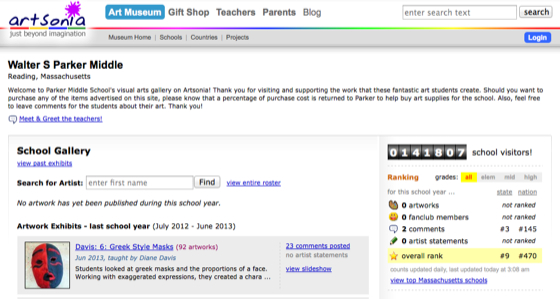
What does your system for using Artsonia’s artist statements look like?
Amy and I work differently with artist statements. She posts a class form where students can find their artwork and write artist statements online. This form allows the teacher to post specific questions for students to answer in their statements. At the end of the day, the teacher is able to read all the artists statements in one file, and approve or have students edit them before they are posted. This works particularly well for Amy as she is the digital art teacher and has computers in her classroom. Students will sometimes work on this as a group activity, or write their artist statements when they have independent time.
I have students write their artist statements on paper, following either the art evaluation form of Describe, Analyze, Intent and Judgement, or I create a specific list of questions I want students to answer. I find this useful in part, because I don’t need to sign out the computer lab, and because it allows students to work at their own pace. It gives me an opportunity to look over their work and have them revise, if necessary, during the same class period. Students take pictures of their artwork as soon as they finish it, and I post those pictures at the end of each day. When I have a batch of artist statements, I go to the posted artwork and type in their statements or they can type them in from home. This year, my art room has acquired several iPads. I will still have students turn in their artist statements, but I hope to have many more students type in their final artist statements in class.
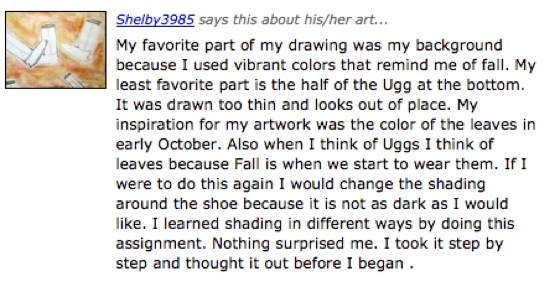
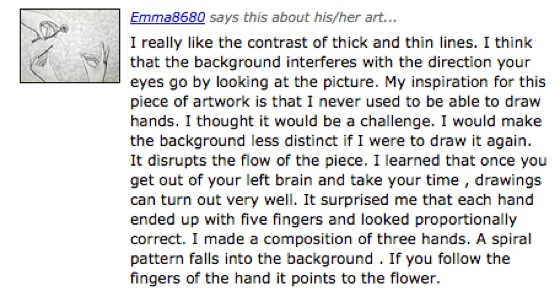
What do you feel are the biggest pros and literacy benefits of using Artsonia’s artist statements? Are there any drawbacks?
Art is a form of communication, but students aren’t always clear when communicating in visual form. Middle-schoolers also find it difficult to talk about their art when asked directly. An artist statement gives the student time to think and respond to their art. It allows them to point out details or themes that might not be obvious at first glance. It focuses the viewer’s attention in a particular direction so that the art can be better understood.
Artist statements help students behave like artists. Students begin to understand their own art process and development by paying attention to how they obtained ideas, what they felt about an issue, or what research was used in developing or editing a piece. We also look to museums and other public art sites that regularly display artist statements to help audiences understand and enjoy the work.
Artist statements reinforce literacy skills by having students write in full sentences, using paragraphs, punctuation, and organization. I once had a student ask me why I was having them write an essay, complaining that it wasn’t an English class. But it was obvious when he was finished, that his short essay added tremendously to the understanding of his artwork. It reinforces the visual story.
The only drawback to using artist statements with Artsonia is that they take time. Teachers need to find time to type and post them, or have students or volunteers do so.
Are you using this site to meet Common Core requirements?
We have been using artist statements since I began teaching at Parker. It has always been an important tool in helping students to reflect on and refine their work. It helps them to connect ideas, to analyze and interpret what they are seeing and making and to evaluate their artwork. The Common Core requirements reinforce what the arts have long been using for reflection, evaluation and critique work.
Discuss any feedback you have received from parents/families or administration/staff.
Families love to see their children’s artwork and writing online. Several families have fan clubs of aunts, uncles and grandparents from across the United States. Parents have said that they love getting a notice each time a piece of art is posted and look forward to seeing it online.
Administration has commented that we are reinforcing writing and thinking skills in other classes. Students are familiar with writing formats because they are used to writing in art.
A HUGE thank you to Diane for sharing her experiences and expertise with Artsonia’s artist statements!
Do you use artist statements in your art room? If so, what does your process look like? Feel free to share your examples below! If not, what is holding you back?
Does anyone else have tips for using the Artist Statement feature in Artsonia?
Magazine articles and podcasts are opinions of professional education contributors and do not necessarily represent the position of the Art of Education University (AOEU) or its academic offerings. Contributors use terms in the way they are most often talked about in the scope of their educational experiences.

